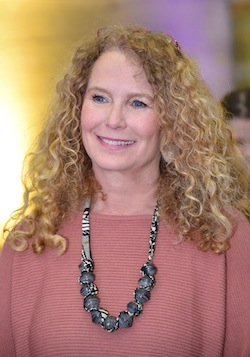A celebration of Sigd at Ruppin College. (photo from Ruppin College)
From 1967 until the First Intifada, Palestinians filled a similar role in Israel to that of foreign labourers in many Western countries, often working in construction, agriculture and other occupations in which Israeli citizens weren’t interested. But, once the Intifada began in the late 1980s and Israel started restricting the passage of Palestinians to and from Israel, there were acute labour shortages.
According to Prof. Galia Sabar, president of Israel’s Ruppin Academic Centre (or Ruppin College), a few other factors contributed to this situation. Specifically, there was the migration of Jews from the former Soviet Union, she said. “So, you have these two mega historical events – the closure of the entrance of Palestinian workers … at the time, there were about 120,000 Palestinian workers coming in and out every day to Israel…. And, on the other side, you had about a million Jews coming within a period of less than two years.
“The Israeli government had several options. One was to have Israeli citizens work in these fields. Another was to have the new migrants [do the] work. The third one was to bring back the Palestinians. And, the fourth option was to bring in international migrant workers to do the job.”
The Israeli government chose the fourth option. However, said Sabar, “The Israeli government opted to ignore the experience in other Western countries. Now, we’re not talking about the 1960s; this is the 1990s. If the Israeli government or decision-makers would have just looked west to Germany and France, they would have noticed what the long-term consequences would be. But, you don’t bring them for a short period of time and, when the work is done, kick them out. It just doesn’t work. That is exactly what happened in Israel.
“With the Palestinians, they came to work in the morning and went back to their homes in the West Bank and Gaza at night. Israelis benefited from cheap labour and didn’t pay the price that most countries did with conventional migrant workers. Once you bring in international migrant workers, they establish families and demand rights.
“Once the borders were open and visas were issued for international migrant workers – and the price Israelis paid for their labour was much lower than paying for Israelis – then all hell broke loose. By 1996, there were already 180,000 visas issued to international migrant workers.
“Once the Israeli economy and borders were open to international labour migrants from specific countries with work visas, others without working visas started coming, too – from Latin America and the African continent. They came in on tourist or pilgrim visas and overstayed their visas … becoming illegal or undocumented migrant workers.”

Sabar started her research in the mid-1990s on communities of Guineans, Nigerians, and Kenyans. She recalled, “We had, at one point, representatives from about 25 different African countries in Tel Aviv alone – my first research was on African churches in Tel Aviv. The Jewish, predominantly white, city had about 55 to 60 different independent African churches just near the central bus station in southern Tel Aviv.
“A Guinean man or woman came and brought other relatives. Kids were born and whole new ecosystems of foreign migrant communities developed in Israel … around construction sites and agricultural places, and in and around the big city where people found work.
“I think most Israelis, until the early 2000s, preferred to ignore what was going on and enjoyed the cheap labour. If, before, a normal family had to take care of an elder person or sick person, they had to pay thousands and thousands of dollars to get 24/7 care. But, here you’d bring a Thai or Philippine caregiver and pay her $800 to $900 … so why worry about the long-term consequences?”
Eventually, in early 2000, the government began deporting undocumented migrant workers. Within a very short period of time, about half of the 250,000 undocumented workers were deported.
“I followed them after they were deported back to Africa, mainly West African countries,” said Sabar. “Since the beginning of the 2000s, I’ve been studying African asylum seekers, mainly Sudanese, who came via the border between Israel and Egypt, to Israel. I followed them after they returned to South Sudan in 2012. “Some who were in Israel for 10 or 12 years had savings and gained new skills, ideas, and resettled back home successfully. The other group was not as well off when they went back home. Their savings were slowly eaten away by their families. They were really wandering around. There were some who were devastated and had no future back home.”
Sabar’s focus now is on what she calls “the second wave,” with which Israel has been grappling since late 2006 – asylum seekers, mostly from Darfur and South Sudan, who came to Israel via Egypt claiming asylum. By 2012, the total number of asylum seekers had reached 60,000.
“Israel never had an office that deals with asylum requests, because we didn’t have asylum seekers coming in or refugees,” said Sabar. “It was only one or two, here or there. We’d get a boat with several dozen Vietnamese … but that was nothing. Then, suddenly, from 2006 on, we have thousands of people coming into Israel seeking asylum.
“In the beginning, it was Darfurians who were considered to be genocide survivors, and South Sudanese, which Israel has special relation with. So, Israel came up with this new idea, like an umbrella protection visa, [and] between 2006 and 2017, the 60,000 Sudanese and Eritreans built their lives in Israel. They worked, earned salaries, rented rooms, had kids, created families, lived full lives. Most of them lived in and around big cities where they could find work.”
Some Israeli ministers and other politicians started calling African asylum seekers a cancer in the heart of the Jewish nation and a “hygienic danger,” said Sabar – statements that, not so long ago, were directed at European Jews.
“I think that, owing to our own history and supposedly Jewish values, we can’t adopt this attitude,” she said. “A few thousand African asylum seekers are not a threat to the state of Israel, to the Jewish character. They are not. There have been no more asylum seekers coming into Israel since the erection of the border (between Israel and Egypt).
“We have now, in 2018, 37,000 African asylum seekers. Now, the state of Israel either puts them in jail or forces them to go to Uganda and Rwanda. But, they don’t come from there…. Where did they get this idea? Why? Because they’re both from Africa? They’re black, so that’s why we can deport them? The idea that the Israeli government is going to take thousands of Sudanese – some of them survivors of genocide – and throw them into Rwanda is terrible.”
Sabar went to Rwanda and Uganda on research missions in 2012, 2013 and 2014. She interviewed asylum seekers who were pushed out of Israel, back into refugee life, but in countries with far less than Israel’s gross domestic product and economic growth. Sabar said Israel should share the burden with the rest of the world and give asylum seekers a temporary home.
Although her efforts have mostly fallen upon deaf ears, the Dalai Lama has taken notice and has bestowed upon her the Unsung Heroes of Compassion award. “I thought it was one of these online scams, but then I communicated with them and realized it was real,” said Sabar. “I feel truly honoured, excited, and very, very surprised that the Dalai Lama acknowledges the fact that academics who do research can bring about real change. That is truly inspiring and gives me, up until today, energy to continue training my students to be critical thinkers and develop empathy for others while doing their research.
“All our students at Ruppin are encouraged to do some kind of activism as part of their academic training. A very high percentage of our students are socially engaged and active.”
While Sabar acknowledged that all sovereign states have the right and the duty to protect, first and foremost, their own citizens and territory, she is adamant that countries “should all have big doors, windows and avenues for those less fortunate seeking asylum, letting them in for temporary shelter and protection.”
Rebeca Kuropatwa is a Winnipeg freelance writer.

